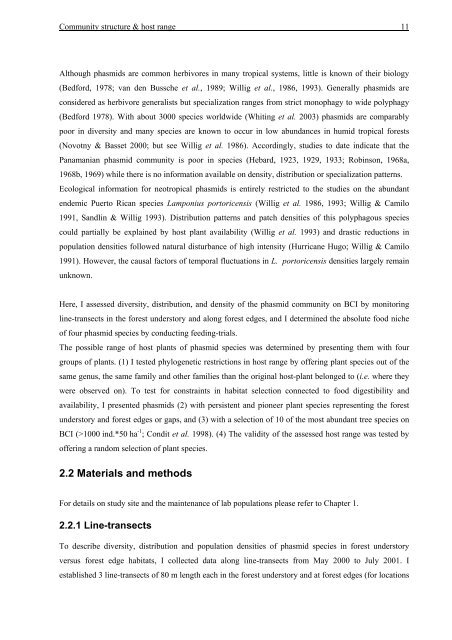ecology of phasmids - KLUEDO - Universität Kaiserslautern
ecology of phasmids - KLUEDO - Universität Kaiserslautern
ecology of phasmids - KLUEDO - Universität Kaiserslautern
Create successful ePaper yourself
Turn your PDF publications into a flip-book with our unique Google optimized e-Paper software.
Community structure & host range 11<br />
Although <strong>phasmids</strong> are common herbivores in many tropical systems, little is known <strong>of</strong> their biology<br />
(Bedford, 1978; van den Bussche et al., 1989; Willig et al., 1986, 1993). Generally <strong>phasmids</strong> are<br />
considered as herbivore generalists but specialization ranges from strict monophagy to wide polyphagy<br />
(Bedford 1978). With about 3000 species worldwide (Whiting et al. 2003) <strong>phasmids</strong> are comparably<br />
poor in diversity and many species are known to occur in low abundances in humid tropical forests<br />
(Novotny & Basset 2000; but see Willig et al. 1986). Accordingly, studies to date indicate that the<br />
Panamanian phasmid community is poor in species (Hebard, 1923, 1929, 1933; Robinson, 1968a,<br />
1968b, 1969) while there is no information available on density, distribution or specialization patterns.<br />
Ecological information for neotropical <strong>phasmids</strong> is entirely restricted to the studies on the abundant<br />
endemic Puerto Rican species Lamponius portoricensis (Willig et al. 1986, 1993; Willig & Camilo<br />
1991, Sandlin & Willig 1993). Distribution patterns and patch densities <strong>of</strong> this polyphagous species<br />
could partially be explained by host plant availability (Willig et al. 1993) and drastic reductions in<br />
population densities followed natural disturbance <strong>of</strong> high intensity (Hurricane Hugo; Willig & Camilo<br />
1991). However, the causal factors <strong>of</strong> temporal fluctuations in L. portoricensis densities largely remain<br />
unknown.<br />
Here, I assessed diversity, distribution, and density <strong>of</strong> the phasmid community on BCI by monitoring<br />
line-transects in the forest understory and along forest edges, and I determined the absolute food niche<br />
<strong>of</strong> four phasmid species by conducting feeding-trials.<br />
The possible range <strong>of</strong> host plants <strong>of</strong> phasmid species was determined by presenting them with four<br />
groups <strong>of</strong> plants. (1) I tested phylogenetic restrictions in host range by <strong>of</strong>fering plant species out <strong>of</strong> the<br />
same genus, the same family and other families than the original host-plant belonged to (i.e. where they<br />
were observed on). To test for constraints in habitat selection connected to food digestibility and<br />
availability, I presented <strong>phasmids</strong> (2) with persistent and pioneer plant species representing the forest<br />
understory and forest edges or gaps, and (3) with a selection <strong>of</strong> 10 <strong>of</strong> the most abundant tree species on<br />
BCI (>1000 ind.*50 ha -1 ; Condit et al. 1998). (4) The validity <strong>of</strong> the assessed host range was tested by<br />
<strong>of</strong>fering a random selection <strong>of</strong> plant species.<br />
2.2 Materials and methods<br />
For details on study site and the maintenance <strong>of</strong> lab populations please refer to Chapter 1.<br />
2.2.1 Line-transects<br />
To describe diversity, distribution and population densities <strong>of</strong> phasmid species in forest understory<br />
versus forest edge habitats, I collected data along line-transects from May 2000 to July 2001. I<br />
established 3 line-transects <strong>of</strong> 80 m length each in the forest understory and at forest edges (for locations

















